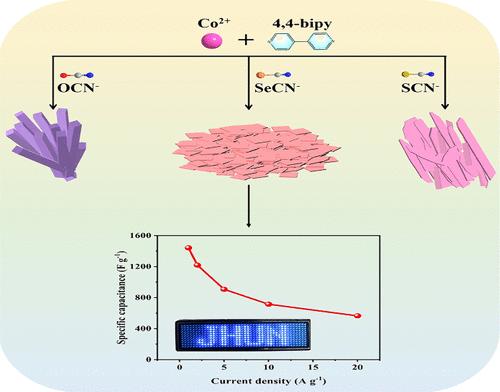Two-Dimensional Cobalt Coordination Polymers Based on Anionic Modulation and Application in Supercapacitors
IF 4.7
2区 化学
Q1 CHEMISTRY, INORGANIC & NUCLEAR
引用次数: 0
Abstract
Supercapacitors are promising energy storage device due to their rapid charge/discharge, high power density and long cycle life. Two-dimensional (2D) Coordination Polymers (CPs) exhibit significant potential for electrochemical energy storage. However, controlling the morphology of 2D CPs remains challenging. Controlling the morphology of 2D CPs remains challenging. In this study, pseudohalide anions (SeCN–, SCN–) were employed as crystal growth modifiers to achieve precise morphological control, leveraging their distinct coordination capacities and steric hindrance effects. Specifically, the large atomic radius and high polarizability of Se in SeCN– facilitate the lateral growth of CPs, leading to the formation of uniform lamellar structures. Co-CP-Se delivered a specific capacitance of 1483 F g–1 at 1 A g–1 and maintained 93.23% of its initial capacitance after 5000 cycles at 10 A g–1. A hybrid supercapacitor (Co-CP-Se//AC) demonstrated a power density of 750 W kg–1 at an energy density of 42.14 Wh kg–1 while maintaining 90.12% capacitance retention after 5000 cycles (10 A g–1). Mechanistic investigations revealed that partial substitution of −SeCN by OH– during cycling generated Co(OH)2, which synergistically contributed to the capacitance together with Co-CP-Se. The uniform lamellar architecture optimized the electrolyte-electrode interface contact and offered critical insights for the structural design of 2D CPs toward high-performance energy storage applications.

基于阴离子调制的二维钴配位聚合物及其在超级电容器中的应用
超级电容器具有快速充放电、高功率密度和长循环寿命等优点,是一种很有前途的储能器件。二维配位聚合物(CPs)在电化学储能方面具有重要的潜力。然而,控制二维CPs的形态仍然具有挑战性。控制二维CPs的形态仍然具有挑战性。在本研究中,假卤化物阴离子(SeCN -, SCN -)被用作晶体生长调节剂,利用其独特的配位能力和位阻效应来实现精确的形态控制。具体来说,Se在SeCN -中的大原子半径和高极化率有利于CPs的横向生长,从而形成均匀的片层结构。Co-CP-Se在1 a g-1下的比电容为1483 F g-1,在10 a g-1下循环5000次后保持93.23%的初始电容。混合超级电容器(Co-CP-Se//AC)在42.14 Wh kg-1能量密度下的功率密度为750 W kg-1,在5000次循环(10 A g-1)后保持90.12%的电容保持率。机理研究表明,在循环过程中,- SeCN被OH -部分取代,生成Co(OH)2, Co(OH)2与Co- cp - se共同促进了电容的产生。均匀的层状结构优化了电解质-电极界面接触,为面向高性能储能应用的2D CPs结构设计提供了重要见解。
本文章由计算机程序翻译,如有差异,请以英文原文为准。
求助全文
约1分钟内获得全文
求助全文
来源期刊

Inorganic Chemistry
化学-无机化学与核化学
CiteScore
7.60
自引率
13.00%
发文量
1960
审稿时长
1.9 months
期刊介绍:
Inorganic Chemistry publishes fundamental studies in all phases of inorganic chemistry. Coverage includes experimental and theoretical reports on quantitative studies of structure and thermodynamics, kinetics, mechanisms of inorganic reactions, bioinorganic chemistry, and relevant aspects of organometallic chemistry, solid-state phenomena, and chemical bonding theory. Emphasis is placed on the synthesis, structure, thermodynamics, reactivity, spectroscopy, and bonding properties of significant new and known compounds.
 求助内容:
求助内容: 应助结果提醒方式:
应助结果提醒方式:


